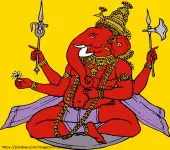Recommended for you
Divine Armor: Narasimha's Mantra

om namo nri'sim'hasim'haaya sim'haraajaaya narakeshaaya namo namaste . om namah' kaalaaya kaaladam'sht'raaya karaalavadanaaya ugraaya ugraveeraaya ug....
Click here to know more..Which is the best spiritual path in the materialistic world?
 Click here to know more..
Click here to know more..
Kalyana Rama Namavali

om kalyaanotsavaanandaaya namah'. om mahaagurushreepaadavandanaaya namah'. om nri'ttageetasamaavri'taaya namah'. om kalyaanavedeepravisht'aaya namah'.....
Click here to know more..
English Topics
Atharva Sheersha
Click on any topic to open
- 4 Ganesha Atharva Sheersha explained-Part 1
- 3 Ganesha Atharva Sheersha explained-Part 2
- 2 Ganesha Atharva Sheersha explained-Part 3
- 1 Ganesha Atharva Sheersha explained-Part 4
Please wait while the audio list loads..
30
Ganapathy
Shiva
Hanuman
Devi
Vishnu Sahasranama
Mahabharatam
Practical Wisdom
Yoga Vasishta
Vedas
Rituals
Rare Topics
Devi Mahatmyam
Glory of Venkatesha
Shani Mahatmya
Story of Sri Yantra
Rudram Explained
Atharva Sheersha
Sri Suktam
Kathopanishad
Ramayana
Mystique
Mantra Shastra
Bharat Matha
Bhagavatam
Astrology
Temples
Spiritual books
Purana Stories
Festivals
Sages and Saints
